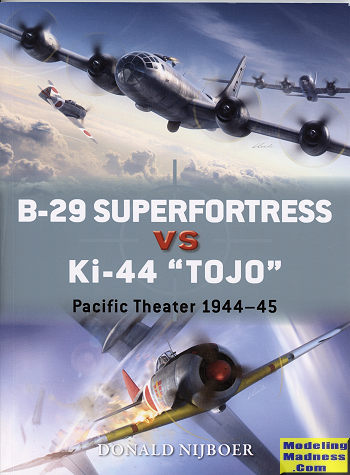 This is the
tale of two aircraft, neither one indented to combat each other, but warfare has
a way of changing things.
This is the
tale of two aircraft, neither one indented to combat each other, but warfare has
a way of changing things.|
Author: |
Donald Nijboer |
|
Publisher/Distributor |
Osprey Publishing |
|
Price |
$20.00 MSRP |
|
Reviewer: |
|
| Notes: |
80 pages, 7¼ x 9¼ inches, softcover ISBN: 978-1-4728-1886-7 |
 This is the
tale of two aircraft, neither one indented to combat each other, but warfare has
a way of changing things.
This is the
tale of two aircraft, neither one indented to combat each other, but warfare has
a way of changing things.
We'll start with the older of the two designs. The Ki-44 was quite a change in fighter design for the Japanese. It was felt that an interceptor was really needed. This would be a plane with the largest available engine so that it could quickly get off the ground and intercept incoming bombers. In this case, it was felt that these would be Soviet.
Japanese pilots were use to maneuverability and this short wing fighter did not have all that much. What it did have was superb climbing and diving abilities. Those who realized it and embraced those features did very well with it. It was also a plane built with armor plating and self sealing fuel tanks, something so far not installed in fighters as these added weight and reduced maneuverability. What it did not have was decent armament. It stuck with rifle calibre guns and some had 12.5mm guns. Later some also got 40mm canon, but those slow firing guns did not have great range (though they did extensive damage when they hit).
On the other side, the US was looking for a bomber that would fly high above enemy fighters and have great range as well. Originally designed to use in Europe, it was realized that what was there was good enough so the focus switched to the Pacific where its superior range would be effective. It had many innovations including pressurization and remote control turrets. It also had temperamental engines. Glitches inthe engines and the remote turrets plagued the aircraft throughout its WWII career, but the plane was needed and sent into combat regardless.
Several things happened when the B-29 was used in combat. First of all, it had a terrible time hitting anything from the altitude for which it was designed. The jet stream was unknown and caused real havoc. THere were also issues with the guns as the systems kept failing and while training certainly helped, in the end, the opposition was so minimal that the gunners were often just along for the ride. Bombing accuracy improved as the plane was used at 'standard' altitudes and units started area bombing with incendiaries.
Meanwhile, Ki-44 pilots and other planes had difficulty reaching the altitude of the B-29s. They were good for one pass and that was about it. To even reach 30-35,000 feet took the better part of a half hour by which time the raid was often over. Many pilots resorted to ramming techniques. This improved success, but often at the cost of a pilot. By the time the B-29 switched to lower altitudes, the Japanese were husbanding aircraft in anticipation of an invasion.
You get a good history of the development of both types as well as how crews were trained and how the planes were used in combat. Add in the great photos and color art work and you have a real winner.
November 2017
Copyright ModelingMadness.com
For more on the complete line of Osprey books, visit www.ospreypublishing.com .
If you would like your product reviewed fairly and quickly, please contact me or see other details in the Note to Contributors.